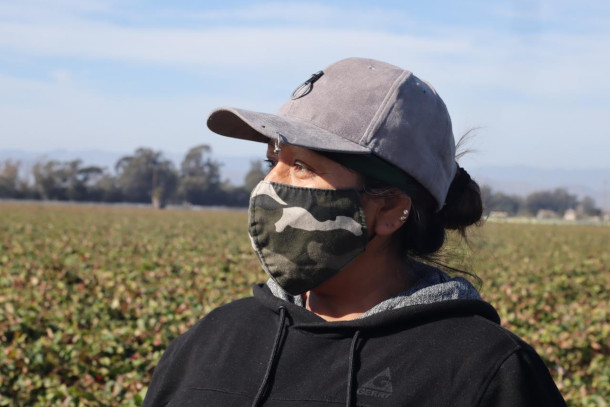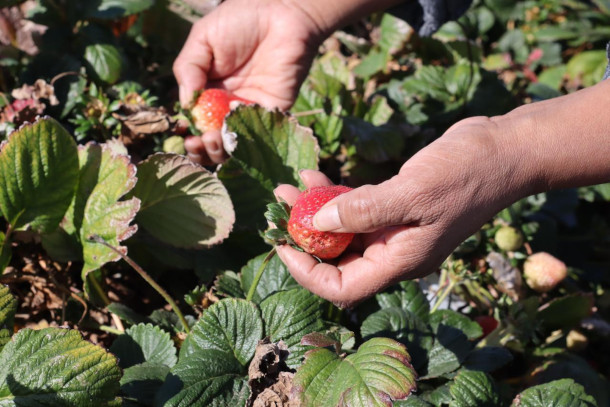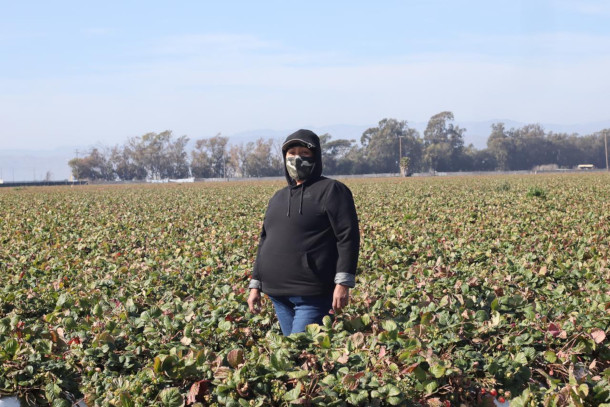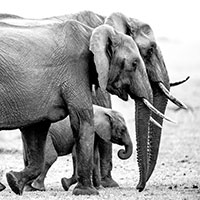Protecting Farmworkers from Wildfire Smoke
Air Date: Week of June 6, 2025

Farmworkers in California are exposed to dangerous levels of particulate matter in the air, and a 2024 study shows that even levels of pollution deemed ‘safe’ by CAL-OSHA can be hazardous to human health. The farmworker shown here is Adriana, whose name has been changed to protect her identity. (Photo: Courtesy of Rambo Talabong)
Poor air quality from wildfire smoke and other pollutants can harm cardiovascular health and also make farmworkers more prone to work injuries, according to researchers. But in California, requirements for employers to hand out face masks do not kick in until the air quality has already deteriorated past the point where farmworkers are experiencing impacts. Reporter Rambo Talabong of Inside Climate News spoke with Living on Earth’s Paloma Beltran about proposals to better protect farmworkers from air pollution.
Transcript
O’NEILL: It’s Living on Earth, I’m Aynsley O’Neill.
DOERING: And I’m Jenni Doering.
Recent days have seen heavy smoke from Canadian wildfires spread into parts of the U.S. as climate change drives more extreme fire seasons. And when it comes to the health and safety of people who grow the food we eat, the poor air quality from that smoke and other pollutants is a top concern. A 2024 study found that current air quality thresholds for some of the smallest particulate matter, known as PM2.5, may leave California agricultural workers dangerously exposed. And this pollution can affect the body in more ways than just the cardiovascular system. The California Division of Occupational Safety and Health or CAL-OSHA sets an air quality threshold for what’s considered "safe" for outdoor workers. But UC Davis economists found that even when air pollution is below that limit, wildfire smoke can increase the risk of farmworkers sustaining injuries like falls and cuts on the job. The study linked workers’ compensation injury claims with wildfire activity across California from 2007 to 2021, estimating at least 282 smoke-related injuries in 2020 alone. Reporter Rambo Talabong covered this research for our media partner Inside Climate News, and he spoke with Living on Earth’s Paloma Beltran.
BELTRAN: What are the PM2.5 thresholds in California, and how do they compare to you know what the researchers in this study recommend?
TALABONG: According to California, our farm workers need to be exposed to 150 AQI that's very high before employers need to protect them and give out face masks, according to researchers of air pollution, even before we hit that threshold, it can be dangerous, and there are also complicating factors here, because farm workers are outside for long periods of time, they're exposed to more pollution. So it's not just a matter of reaching that threshold, but also protecting them even before that threshold is hit. And in California, the researchers found that our farm workers are not protected enough. That's why we also hear a lot of stories where farm workers are saying it's already smoky outside, but we haven't received any single face masks. Our employers are not letting us go home or do flexible time for working to protect ourselves and work another day. So that's how it plays out on the ground.
BELTRAN: What sorts of protections does the state of California require for farm workers when it comes to fires and air pollution? And who's responsible for enforcing those protections?

Adriana often works on a strawberry farm. She has been farming for over twenty years. (Photo: Courtesy of Rambo Talabong)
TALABONG: For California it's Cal/OSHA, and under Cal/OSHA's rules, employers would have to give out at the very least face masks to farm workers when the AQI reaches AQI 150. Again, that's quite high, according to researchers. And compare that to a state like Washington state, their threshold is at around 70. That's around half of what California's is. And according to researchers, giving out face masks actually is not enough. What California needs to do, and what employers need to do in California is to make work days flexible for our farm workers, to give them the opportunity to not work one day and then do extra work in different days so that they can earn back what they have lost in not working. And this is also fair for farmers. For the owner of the farms, they still get productivity from farm workers. It's not a free pass for farm workers, okay, it's a pollution day. They don't have to work, but they still get the money that they deserve. We spoke with farmers, and they also believe that it's fair that farm workers can be granted these extra days of work and hours of work. And what struck me, in the states of Washington, they give a lot of talks to farm workers and farmers about the dangers of higher air pollution, and so that means that they're more informed about the harms that they have when it comes to days when the pollution is bad, and they can decide, okay, I'm probably not going to work today.
BELTRAN: And we're talking about PM2.5 here, this pollutant. What are some of the negative health impacts of exposure to PM2.5?
TALABONG: According to researchers we spoke with about the effect of PM2.5 for heart and lung diseases that are linked to constant exposure to PM2.5, but then what's interesting also with this research paper is that it didn't just focus on long term effects. It's also about immediate effects. We already feel bad or worse when we get exposed to PM2.5 and pollution, even not in the long term, it can happen immediately, and this happens to farm workers. When we are exposed to pollution, our hand-eye coordination and our locomotive coordination is actually impaired because our brains are already impacted by bad air, and agricultural workers are already a very vulnerable population to injuries. They're among the most dangerous professions in the US, and if there is pollution outside, it makes them more vulnerable to hurting themselves, tripping, cutting themselves while harvesting, they might fall. And these are things that the researchers recorded, and this is actually what researchers are also worried about, that while farm workers are outside, they can end up hurting themselves because of pollution.

The study notes that high levels of wildfire smoke correlate with high risk of traumatic injuries for farmworkers, such as those from falls. Researchers focused on traumatic injuries in the workplace, as they are easier to prove a connection with workplace conditions as opposed to non-traumatic illnesses like heart and lung disease. (Photo: Courtesy of Rambo Talabong)
BELTRAN: And for your reporting, you talked to Adriana, whom you changed her name to protect her anonymity. What's her story?
TALABONG: So Adriana moved to the US at a very young age, and for her, it's a matter of having to work or else she wouldn't have money to pay the bills in order to stay in the US and even thrive in her community. And so this in practice shows in how when there are wildfire days, she would force herself to work, and it's harder also for her to leave, because if she doesn't work, and if her fellow coworkers don't work, she wouldn't be able to earn and so it's such a precarious situation wherein she's already exposed to pollution, but she also doesn't want to face, you know, financial insecurity and ruin. She needs the money. And also, sometimes her bosses would essentially tell her, you have to work or you wouldn't be able to come back, because you're essentially expendable.
BELTRAN: And of course, Adriana is one of the many farm workers who is exposed to this dangerous PM2.5 levels. How has her health been impacted throughout the years of her farm working?
TALABONG: Well, first of all, she told me up front that she's recently experiencing a lot of coughs, and she even told me about seeing blood after coughing. And so that's quite worrying that she is experiencing this. But she was also telling me it's hard to prove that to get claims, because the system helps people who immediately have injuries. You see this with contusions, with cuts. You can see them in pain, but with cardiopulmonary and cognitive impacts of pollution, it's harder to prove that it's actually the pollution from working in the field that brought you to that situation. And so when it comes to her working, there are times when she told me that she has fallen because of the blurring the field. But also not just with wildfires. The thing about this too, is that it compounds. You know, there is wildfires, and then sometimes it's also rains, and then it's so hot, too. She's fallen a lot of times. And what's hard here Paloma, is that we can't really draw a line as easy as okay, because it is a bad wildfire day, and so she will fall. It's hard for her, and it's hard for us, and it's hard for researchers, and so we're stuck in this problem of they get injured, and we know that in many of those days, it might be wildfire days or high pollution days, but we can't be sure. That's why I think this research is very important, is because they use modeling.

Rambo Talabong is a New York-based journalist who writes for Inside Climate News. (Photo: Courtesy of Rambo Talabong)
BELTRAN: And how do UC Davis researchers hope that their most recent work will impact protections or change protections for farm workers?
TALABONG: The researchers I spoke with have a background in agricultural economics, so they aren't just outright advocating for these lower the thresholds as much as we can, because they also understand how it might be harder for farmers to comply. The researchers are telling me that we could just gradually decrease the threshold to match other states. And that can actually be helpful for the industry as well, so that when they comply, they can comply with all states, 150 right now for California, around 70 for Washington State. So lowering California's can help farmers too in the industry in complying. Aside from that, they really emphasize that flexible work times can help. This is also fair for the farmers, because even if farm workers don't work one day, the economic output that they expect to have that day can be earned back. They're not saying, Okay, we need the strictest standards as much as possible, because they also understand that if these standards become too strict, farmers wouldn't have enough incentive to employ more farm workers, and that means losing jobs for people like Adriana. It's a matter of informing as many people as possible about what we can do to protect our farm workers.
DOERING: That’s Rambo Talabong, a reporter with Inside Climate News who focuses on environmental justice, speaking with Living on Earth’s Paloma Beltran. We reached out to Cal/OSHA and they did not meet our response deadline but they did point us to a section on Worker Safety and Health In Wildfire Regions on the Cal/OSHA website. There you can find the guidelines for employers to protect workers exposed to wildfire smoke, and we’ll link to it on the Living on Earth website, loe.org.
Links
Read the study from agricultural economists at University of California Davis
Learn more about the intersection of air quality and farmworker safety
The Guardian | “Canadian Wildfires Prompt Air-Quality Alerts Across Five US States”
Living on Earth wants to hear from you!
Living on Earth
62 Calef Highway, Suite 212
Lee, NH 03861
Telephone: 617-287-4121
E-mail: comments@loe.org
Newsletter [Click here]
Donate to Living on Earth!
Living on Earth is an independent media program and relies entirely on contributions from listeners and institutions supporting public service. Please donate now to preserve an independent environmental voice.
NewsletterLiving on Earth offers a weekly delivery of the show's rundown to your mailbox. Sign up for our newsletter today!
 Sailors For The Sea: Be the change you want to sea.
Sailors For The Sea: Be the change you want to sea.
 The Grantham Foundation for the Protection of the Environment: Committed to protecting and improving the health of the global environment.
The Grantham Foundation for the Protection of the Environment: Committed to protecting and improving the health of the global environment.
 Contribute to Living on Earth and receive, as our gift to you, an archival print of one of Mark Seth Lender's extraordinary wildlife photographs. Follow the link to see Mark's current collection of photographs.
Contribute to Living on Earth and receive, as our gift to you, an archival print of one of Mark Seth Lender's extraordinary wildlife photographs. Follow the link to see Mark's current collection of photographs.
 Buy a signed copy of Mark Seth Lender's book Smeagull the Seagull & support Living on Earth
Buy a signed copy of Mark Seth Lender's book Smeagull the Seagull & support Living on Earth

